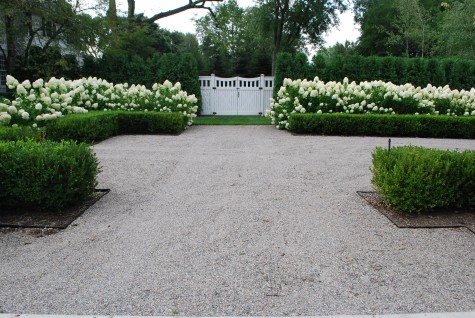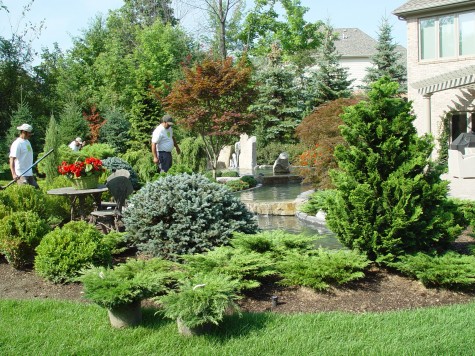 Being Labor Day weekend, I knew I could expect the weather to change. Sure enough, it was 51 degrees when I came to work this morning, and I hear I can expect 48 degrees overnight. Our British born Christine who works weekends came in today in shorts-and a sweatshirt-grumbling about how “perishing cold” it was. The onset of fall gets me to thinking about reworking the garden-so it might be better next season. But fall also has a way of bringing the issue of planting evergreens to the fore-as we have a very long leafless winter season ahead. Norway spruce thrive in our climate; should you have the space, they are brave and comforting against the winter skies.
Being Labor Day weekend, I knew I could expect the weather to change. Sure enough, it was 51 degrees when I came to work this morning, and I hear I can expect 48 degrees overnight. Our British born Christine who works weekends came in today in shorts-and a sweatshirt-grumbling about how “perishing cold” it was. The onset of fall gets me to thinking about reworking the garden-so it might be better next season. But fall also has a way of bringing the issue of planting evergreens to the fore-as we have a very long leafless winter season ahead. Norway spruce thrive in our climate; should you have the space, they are brave and comforting against the winter skies.
 There are many cultivars of thuja; they can be very effective in providing year round privacy. Thuja Smaragd, or Emerald Green arborvitae, takes up little space on the ground compared to the big growing pines. Thuja Nigra is bigger growing, but still fairly vertical. I could not do without them in my small urban garden. In this landscape, thuja Pyramidalis provides privacy on a grand scale.
There are many cultivars of thuja; they can be very effective in providing year round privacy. Thuja Smaragd, or Emerald Green arborvitae, takes up little space on the ground compared to the big growing pines. Thuja Nigra is bigger growing, but still fairly vertical. I could not do without them in my small urban garden. In this landscape, thuja Pyramidalis provides privacy on a grand scale.
 Taxus media “Moon” is an upright growing yew that rarely needs any side pruning. Taxus media “Hicks” is the old standby for vertical yews, but they are much more open in growth. Choosing the right cultivar of evergreen for your purpose is important. The natural habit of a plant is a vastly superior to that too heavily pruned look.
Taxus media “Moon” is an upright growing yew that rarely needs any side pruning. Taxus media “Hicks” is the old standby for vertical yews, but they are much more open in growth. Choosing the right cultivar of evergreen for your purpose is important. The natural habit of a plant is a vastly superior to that too heavily pruned look.
 I use Green Velvet boxood almost exclusively-as it keeps its color and performs well even when we have terrible winters. It tolerates shearing well. Should I need boxwood that grows taller, or bigger than 3′ by 3′, Buxus microphylla var koreana is a good choice. It is much more open growing than Green Velvet, but sometimes the eventual scale of a plant is the most important issue. The foliage of Green Mountain boxwood is very close in appearance to Green Velvet, and matures at 4′ by 3′. Vardar Valley boxwood has a beautiful blue cast. Faced down with Japanese painted ferns-really beautiful. Boxwood is handy as a companion planting to deciduous shrubs. It helps to relieve that twiggy look, or that cut to the ground perennial garden look-in the winter.
I use Green Velvet boxood almost exclusively-as it keeps its color and performs well even when we have terrible winters. It tolerates shearing well. Should I need boxwood that grows taller, or bigger than 3′ by 3′, Buxus microphylla var koreana is a good choice. It is much more open growing than Green Velvet, but sometimes the eventual scale of a plant is the most important issue. The foliage of Green Mountain boxwood is very close in appearance to Green Velvet, and matures at 4′ by 3′. Vardar Valley boxwood has a beautiful blue cast. Faced down with Japanese painted ferns-really beautiful. Boxwood is handy as a companion planting to deciduous shrubs. It helps to relieve that twiggy look, or that cut to the ground perennial garden look-in the winter.
 There are no end of interesting and visually arresting cultivars of dwarf evergreens. Though I am neither a connoisseur nor collector, I know a beautiful and well grown evergreen when I see one. People who love dwarf conifers really really love them. Designing a landscape for a collection is great fun. For each specimen plant or plant grouping I may choose a companion evergreen that will showcase that specimen. The juniper “Calgary Carpet” is a juniper I can take to. This prostrate evergreen has needles with a silvery sheen that is very attractive.
There are no end of interesting and visually arresting cultivars of dwarf evergreens. Though I am neither a connoisseur nor collector, I know a beautiful and well grown evergreen when I see one. People who love dwarf conifers really really love them. Designing a landscape for a collection is great fun. For each specimen plant or plant grouping I may choose a companion evergreen that will showcase that specimen. The juniper “Calgary Carpet” is a juniper I can take to. This prostrate evergreen has needles with a silvery sheen that is very attractive.
 Given my druthers, I would only plant blue needled evergreens far in the distance. Everything at a great distance in a landscape has that far away blue cast. The color blue seems so natural-far off. But creating an informal tapestry of various shades of green can be very appealing.
Given my druthers, I would only plant blue needled evergreens far in the distance. Everything at a great distance in a landscape has that far away blue cast. The color blue seems so natural-far off. But creating an informal tapestry of various shades of green can be very appealing.
 This old dwarf scotch pine on standard rules this view-never mind a climbing hydrangea that has been draped over this wall for decades. All of the attending horizontal elements make much of the singular shape of this specimen evergreen.
This old dwarf scotch pine on standard rules this view-never mind a climbing hydrangea that has been draped over this wall for decades. All of the attending horizontal elements make much of the singular shape of this specimen evergreen.

The most commonly planted evergreens in my area represent but a fraction of what is available to plant. In the above photograph, Pinus Flexilis “Vanderwolf’s” on the left, and Pinus Heldreichii Leucodermis further down the drive. One of the nurseries where I buy plants lists 42 cultivars of Chamaecyparis alone. This is more than enough to replace one’s regret at the passing of the summer with an interest in making some new friends.